Chess gone mainstream
February 19th, 2017 will go down in history of chess as a date when chess became an integral part of the mainstream popular culture.
Because on February 19th, 2017, the 15th episode of the 28th season (already?!) of the Simpsons, labeled “The Cad and the Hat“, officialy aired.
An episode in which apart from standard brother-sister love between Bart and Lisa Simpson, also introduces Homer Simpson as a “chess savant” and features the Chess World Champion Magnus Carlsen as a guest.
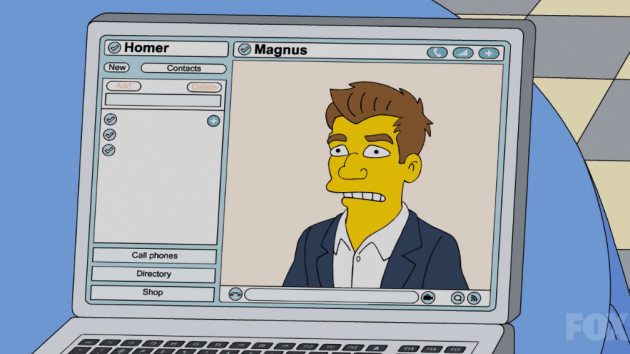
The reaction of the chess community worldwide was predictable. Since chess is often underestimated and rarely publicized in the media, everybody was delighted that chess came under the spotlight for once.
Even though there are some people who think that Simpsons should have been canceled some 10 years ago. But haters gonna hate..
The following reddit thread is the best evidence of both claims presented above.
However, although by far the most prominent, the leading role played by chess in the Simpsons is not the only instance of appearance of chess in popular culture.
Throughout the last century there has been a significant amount of chess references in books, movies, musical videos and insanely politicaly correct internet comics.

Therefore, I’ve decided to make an overview of the most important instances of chess appearing in popular culture.
Hope you will enjoy getting acquainted with science fiction, con artists, Serbian folk music and beautiful woman.
[Spoiler alert]
I have mentioned important plot details of the various movies/books/comics in this post. So be warned!
[/Spoiler alert]
Harry Potter and the Sorcerer’s Stone
If you are a 90s kid, prepare yourself for a huge burst of a nostalgia for starters.
Because I reckon there is a very high probability that the book series about The-boy-who-lived brought alot of joy and delight into your childhood.
Unless you spent your childhood going around burning the books together with the work of Stephen King and AC/DC albums.
In that case I doubt there was joy and delight in your life at all.

Anyway, one of the most prominent public exposures of chess made its appearance already in the first book of the series, The Sorcerer’s Stone.
Because when they aren’t saving the world, learning the spells or having a confusing mixes of feelings typical for teenagers, the heroes of the story like to play the wizard chess in their free time.

The wizard chess has the same rules as the conventional chess. The only slight difference is the fact that the pieces communicate with the players and that they capture one another in quite brutal and violent fashion.
The wizard chess is very important throughout the first book. Apart from making Ronald Wesley good at something, winning in wizard chess on a giant chessboard is one of the key tasks in the labyrinth that leads to the Sorcerer’s stone.
The three youngsters take places of the three pieces on the chessboard and Ronald Wesley conducts the game heroically, sacrificing himself in the key moment to ensure the checkmate of the opposing king.
And also another one of Rupert’s Grint silly faces in the movie adaptation of the book.
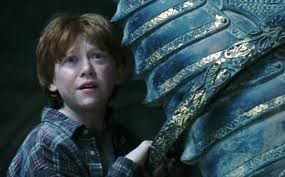
The pure chess part of the movie is actually quite interesting. The producers actually hired the International Master Jeremy Silman to invent an interesting position for the purpose of the movie:
While analyzing the position, I realized the horrible blunder made by Rowling and repeated by the movie director.
It was a terrible blunder not to have Harry playing as the h-pawn.
The Seventh Seal
For another famous and celebrated chess scene, we have to dive back in the year 1957.
Because this is the year when famous Swedish director Ingmar Bergmann made his virtually most famous movie, The Seventh Seal.
Bergman tells the tale about Antonius Block, a knight returning from the Crusades. Upon returning home, he sees his homeland ravaged by famine and plague.
What is even worse, Death himself, depicted as a tall black man, has come to take him to the other world as well.
In such a depressing situation, Block makes the only logical and reasonable move. He challenged the Grim Reaper to a game of chess, with his life depending on the outcome.
Because apparently being good at chess increases your chances of living a long and prosperous life.
The chess aspect of the game is somewhat shrouded with mystery. I will quote the words of chess arbiter Stewart Reuben here (taken from this article):
“It’s very common for filmmakers to get things wrong. Although the film is set in the 14th century, it’s almost certain that they are playing to the rules established in the 15th century. Death makes a move, followed by white checking the King, followed by Black putting his King out of the way, but then the game dissolves away.”
“The thing is, the game doesn’t flow,” observes Reubens. “What you’d expect is, as the game goes on, there to be fewer and fewer pieces on the board. What you would never expect to happen is that there are more and more pieces on the board, even though they are being exchanged off as it goes.”
Nevertheless, perhaps it is better not to cavil and simply to enjoy this great movie.
Dylan Dog: Partita Con la Morte
Chess game against the Death also makes its appearance in one of the episodes about Dylan Dog, the famous nightmare hunter.
Dylan Dog is a part of the Italian popular culture that is reasonably popular throughout the Europe. Most of the issues were translated into Croatian as well.
However, it seems like it hasn’t been as influental in the Anglo Saxon culture.
Anyway, the issue number 66, under the title Partita con la morte (a rough translation from Italian meaning: A game against the Death) features the variation of the same theme.

It all starts when the main protagonist Harvey Burton dies. Before he definitely… “continues forward”.. He challenges the Grim Reaper to a game of chess (we have heard this one before, haven’t we).
However, the stakes are much higher. Because whenever Death captures one of Burton’s pieces, he has to chose one person he knows, that Death then “captures” in real world as well.
Burton however is an old bastard full of hate. He tries to cheat Death by choosing people that are apparently close to him, but that he actually wishes were dead.
But naturally, it is not so easy to trick Death. Therefore, upon finding out, she (or he) sends Burton back to life.
Unfortunately for him, Dylan Dog finds out what’s happening, because one of the chosen victims is a girl he sleeps with.
Long story short, due to his actions, Burton finds himself somewhere between life and death.

Quite morbid, right?
Who would imagine that inventors of something as beautiful as Pizza and Spaghetti are also capable of inventing something as disturbing as Dylan Dog series?
2001: A Space Odyssey
Another very famous chess scene from the Stanley Kubrick’s 2001: A Space Odyssey is also the first chess game of a human against the machine in the history.
For the sake of the accuracy of the sentence above, we will not regard the famous chess automaton The Turk as a machine.

In the movie, one of the astronauts, Dr. Frank Poole, plays a recreational game with the supercomputer Hal 9000.
It is interesting to observe that no particular mention of the chess game in Arthur Clarke’s novel is made. It is merely mentioned that the astronauts play chess and other games occasionally against the computer and that Hal is programmed to win “only” 50 % of the games.
The actual game is quite interesting, as it features the position from the very attractive game between lesser known masters Roesch and Schlage from the beginning of the 20th century.
Star Trek
Recently, I have asked a close personal female… acquitance.. whether she watches Game of Thrones.
Her response went something along the lines:
“Isn’t that show only followed by those… wierd people?”
I didn’t even try to proceed with Star Trek references after that. But since we have already started going in the SF direction with the previous part of the post, there is no way out now.
True fans of Star Trek have benefited heavily from following their favourite show throughout the years:
- Star Trek has improved their linguistic capabilities by being forced to learn the Klingon Language (I have just found out that The Klingon Language Institute actually exists)
- Star Trek has allowed the kids to be cool by allowing them to play the advanced version of the Rock – Paper – Scissors game
- Star Trek has introduced one of the most popular chess variants out there or the so called 3d chess

If you want to rule the rules of 3d chess, it is not that simple. The history of the rules of the 3d chess is very complicated and I haven’t managed to find a 100% reliable source for learning the game.
The most of the literature is more occupied with the pure process of manufacturing the board. The Star Trek history bible, the Starfleet Technical Reference Manual gives detailed instructions about making your own board, but there is zero information about the rules of the game.
Therefore, I am sorry to inform you, but you probably won’t get the role in the new season of the Big Bang Theory and the opportunity to beat the master of 3d chess, dr. Sheldon Cooper.
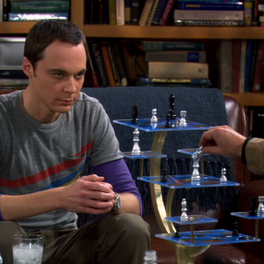
James Bond: From Russia with Love
Although I have watched almost every James Bond sequel out there, I was still rather surprised when I found out that there is a chess scene featured as early as movie number two.
Somehow I have forgotten that the main villain of the infamous SPECTRE organization featured in From Russia With Love, is also a chess grandmaster.
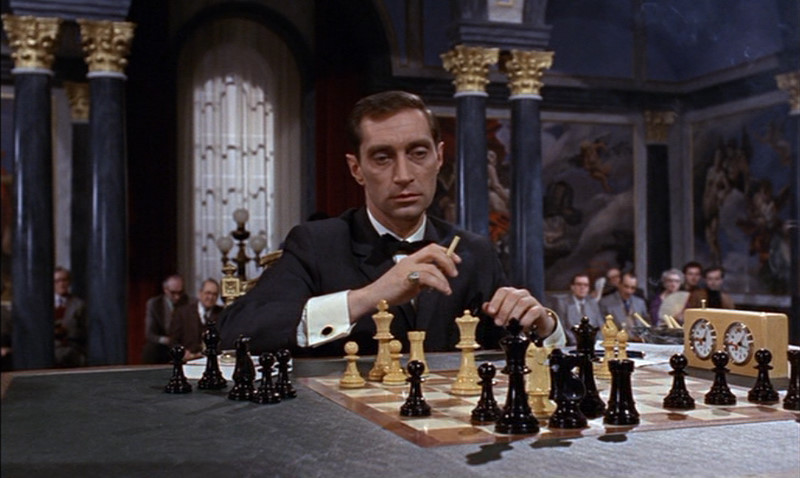
In the opening scene of the movie, the head of the SPECTRE, Kronsteen, also known as “number 5”, uses a brilliant combination to beat the Canadian grandmaster, McAdams.
Naturally, the combination comes in the crucial moment of a match the duo plays in Venice, Italy. The game is played with the result standing at 11.5 – 11.5, and with the nice tactical sequence Kronsteen wins the match.
The whole scene is available on youtube:
This fictional game was inspired by a real life encounter. Moreover, the directors of James Bond have copied quite a famous chess game. The King’s Gambit game between Boris Spassky and David Bronstein from the 1960 USSR Championship.
Bronstein’s comment is well worth noting:
“I don’t know what kind of Devil possesed me to reply with e5. I have forgotten that Spassky, very much as Spielmann in the past, enjoys playing the King’s Gambit.”
Pawn Sacrifice
Moving away from the world of fiction, the next three chess appearances will be more biography/drama orientated.
Let’s start with the movie that probably caused even more stirr in the chess world than the aforementioned Simpsons’ episode.
I am talking about the movie that allowed Tobey McGuire’s one and only I-am-on-the-verge-of-crying face gain some credibility.
The biographical movie about Robert James Fischer. The Pawn Sacrifice.

The movie follows the life and games of Bobby Fischer, culminating in the so-called “Match of the Century”, a World Championship match against the Soviet Grandmaster Boris Spassky.
Naturally, since the match happened during the Cold War, movie depicts the match as the clash of ideologies.
For instance, I found the scene in which Nixon follows the chess game on the TV-set very dramatic.
The movie crew has really made a thorough and detailed preparation.
In preparing to write the movie’s script, screenwriter Steven Knight read many of the books that have been written about Bobby Fischer and the “Match of the Century”, as well as speaking with people who knew him.
“The most useful material was archival footage of him being interviewed,” said screenwriter Knight. “Bobby spoke and moved oddly, and to see that was helpful. If you noticed him walking down the street, you’d think, ‘there is a curious person’. He might have ended up just another homeless person, but he was just so good at chess that he was saved by it. And, of course, cursed by it as well.”
And whereas the magnitude and importance of the “Match of the century” are well known to any chess player, the movie really did alot for chess promotion outside the chess community.

Searching for Bobby Fischer
Another famous chess appearance in the popular culture is once again inevitably linked with the name of Bobby Fischer.
And once again we have an instance of a movie adaptation based on an autobiographical novel by Fred Waitzkin.
In Searching for Bobby Fischer we follow a young chess prodigy, Josh Waitzkin on his path toward becoming a chess champion.

The movie is very touching as we see a seven year old being torn between playing chess for fun and playing chess professionally, as the following scene testifies (source: IMDB) :
Bruce Pandolfini: His chess ideas are like pieces of his body he’s reluctant to give up. For instance, he simply can’t cope with being told not to bring his queen out too early in the game. Why shouldn’t he? He’s won many a game in Washington Square doing exactly that, why is this suddenly wrong?
Fred: Try getting him to brush his teeth sometime.
Bruce Pandolfini: What I’m trying to teach him and what he’s learning there are two very different things. Park hustlers play tactics, not position. They rely on wild, unpredictable moves meant to intimidate their opponent. Great in a two-minute speed game for drug money, but it’ll cost Josh dearly in real games.
Fred: Well, he’s learning some new words!
Bruce Pandolfini: I was wondering if you could keep him from playing there so much.
Fred: Sure.
Bonnie: No. It’d kill him not to play in the park. He loves it.
Apart from boy struggling, we also follow the struggles of his father Fred, who is torn between pushing his son to maximize his potential and allowing him to have a normal childhood.
The tournament in the film was meant to resemble Waitzkin’s 1986 U.S. Primary Championships, in which he drew a tough opponent named Jeff Sarwer (who Jonathan Poe is meant to characterize), to share the championship title. The final game is given below.
It is interesting to note that Joshua Waitzkin won the US. Junior Championships in 1993 and 1994. Nowadays he is probably the best known International Master in the world.
Also, it is interesting to say that Bobby Fischer denounced the movie, claiming that it was part of a “Jewish conspiracy” to sully his name and make money off him at the same time.
This claim tells you alot about Fischer’s character and his extremistic views.
The (Luzhin) Defense
Apart from being a pervert and writing about sexual desires toward little girls in Lolita or brother-sister love in Ada, Vladimir Nabokov was also a very big fan of the game of chess (please don’t get the impression that these two are connected).

His third novel Defense (also known as the Luzhin’s Defense after the movie release) and its movie adaptation The Luzhin’s Defense follow the mentally distressed chess grandmaster Luzhin participating in a World Class tournament in Italy.
Prior to a tournament, he meets a young lady Natalia Katkov, and immediately falls in love with her.
You might anticipate a Disney – like plot in which he wins the tournament, marries the lady and kills the beast-like looking Russian.
However, the plot is much more disturbing (it is Nabokov after all). The ongoing mental issues trouble Luzhin as the tournament progresses (which should be familiar to all chess players out there) and culminate in the final round where he faces his most fierce competitor, Italian grandmaster, Salvatore Turati.

After the game is adjourned, he finishes in the hospital, proposes Natalia, gets out of the hospital only to commit suicide on his wedding day.
In the aftermath, his never-to-be bride completes the game against Turati using Luzhin’s notes. The final combination is actually a chess masterpiece and well worth looking at:
God, I started crying now.
The Twelve Chairs
If you got depressed by all the Nabokov stuff, it is tome to chair you up (these things really bring a bright smile on my face).
Because the satiric genius of the Russian writers Ilya Ilf and Yevgeni Petrov is bound to bring a smile to everybody’s face.
Ilf and Petrov are creators one of the most famous characters of the Russian modernism – a famous con artist Ostap Bender.

In the two epochal novels, The Twelve Chairs and The Golden Calf, Bender travels throughout the Russia, obsessing about travelling to Rio de Janeiro while inventing new ways of operating outside of the law and robbing people of their money.
For the needs of the article, we will focus on the former. In The Twelve Chairs, Ostap Bender joins forces with Ippolit Matveyevich “Kisa” Vorobyaninov.
Vorobyaninov’s mother-in-law admits on her deathbed that she has hid her family jewels in one of the twelve chairs from the family’s dining room set.
Naturally, the chairs were confiscated by the Communists after the Revolution.
In an epic series of adventures the Bender – Vorobyaninov duo hunts the chairs over the whole Russia.
In one of their stops, they get stuck in the small Russian city. Bender devises a “cunning plan” to earn some money.
He finds a local chess club and introduces himself as a grandmaster. He takes advantage over the naive locals by promising them organization of an international chess tournament with participation of Lasker, Capablanca and all other world class players he claims to know personally.
Having gained their trust, he organizes a chess lecture with simultaneous exhibition included. Naturally, everyone pays the fee too see the great player in action.
It goes without saying that everything ends with Bender losing all the games, trying to cheat in every possible way (even stealing pieces) and running away with all the money.

It is ironic that he was often referred to as an enterpreneur in the post – Soviet era.
Dzenan Loncarevic

To conclude, I would like to present mr. Dzenan Loncarevic, a Serbian folk singer, and his brilliant heartbreaking hit, Laufer.
Apart from giant chess board in the music video, this video presents an unique insight into the mind of a typical Balkan boy.
Or a girl.
A rough translation of the chorus is as follows:
“Life isn’t fair..
It makes you think that everything is possible.
And it isn’t.
Beauty and the beast.
Mission impossible just like the two of us.
Black queen and White bishop.”
Very deep.
Great, now I am crying again.
The end?
Hey hey, what about all the beautiful women you promised? You only gave us a teenage Emma Watson.
Okay okay here is a photo from the set of the movie Friends with benefits.
This photo was not a part of the movie and has no relation to chess popular culture whatsoever.
It is also probably the best part of the article.
Those eyes…That smile…
Asthon Kutcher, you lucky bastard.


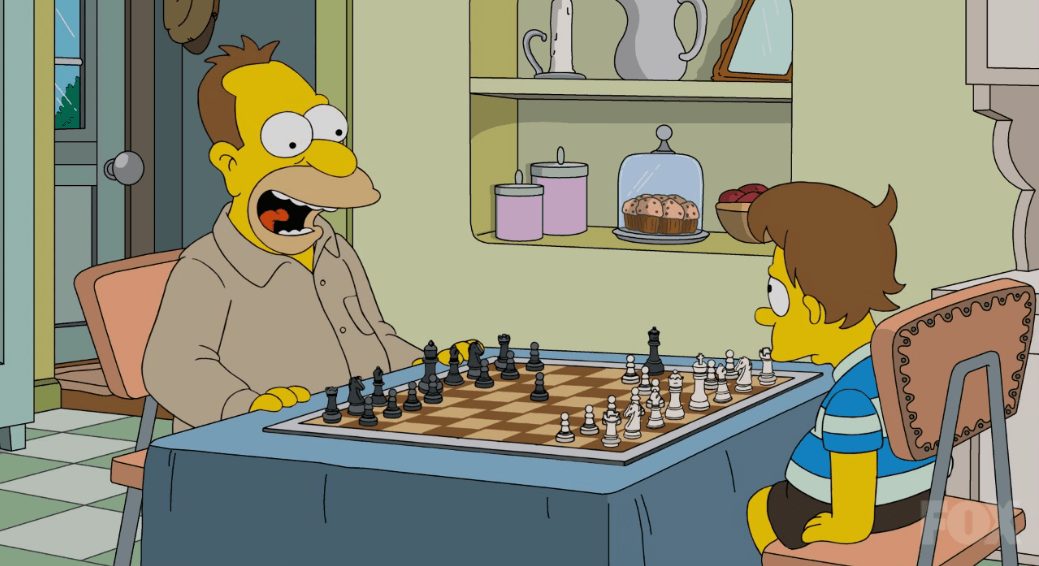

Excelent work and great article Vjeko!
Just wanted to add one chess movie which looks very promising – Capablanca (pelicula) https://www.youtube.com/watch?v=gQShw80vens
It’s in spanish, but even if you don’t understand the language you can feel the atmosphere there around the Latino charmer as Capa was described in many occasions. 🙂
Carlsen’s show up in Simpsons seem to me like Fischers dream come true for chess to become popular and protagonists famous movie stars! 🙂
Btw. famous Croatian band named Laufer has interesting lyrics in the song “World for us” – “don’t give me to see, don’t give me to know, this is not world for us” – this goes for all the people not interested in chess! haha https://www.youtube.com/watch?v=qj5tiA7SJ6g
Thank you very much for your comment Igor.
I will try to watch the Capablanca as soon as possible, I wasn’t aware of it, thanks 🙂
Hmm, I think if Fischer wasn’t such a peculiar character he was, episodes such as chess in Simpsons could have happened much earlier. Because after his match with Spassky there was a real boom in the USA
http://m.imdb.com/title/tt0104627/ 😉
wow, I haven’t heard of this one. Thanks, will try to take a look 🙂
Thank you for this summary. I have to make a speech for my Toasmasters club, so I decided to speak about chess. As part of my speech I wanted to highlight the prominence of chess in pop culture.
One additional reference I can think of is Lewis Carol’s “Alice through the Looking Glass”. If I remember correctly, the whole story inside the Looking Glass is developed on a chess board, not to mention the active role the “White Queen” and the “Red Queen” play in the book.
Hi Anzor,
Thank you very much for this comment.
Thank you for reminding me of Lewis Carol. To be honest, one could probably write a whole book about chess references in popular culture, although I agree that Alice is definitely one of the more prominent.
Good luck with your speech 🙂
Cheers
Vjekoslav
Pingback: Best Books For Chess Players: Top 5 Non-Chess Books Every Chess Players Should Read - Chessentials